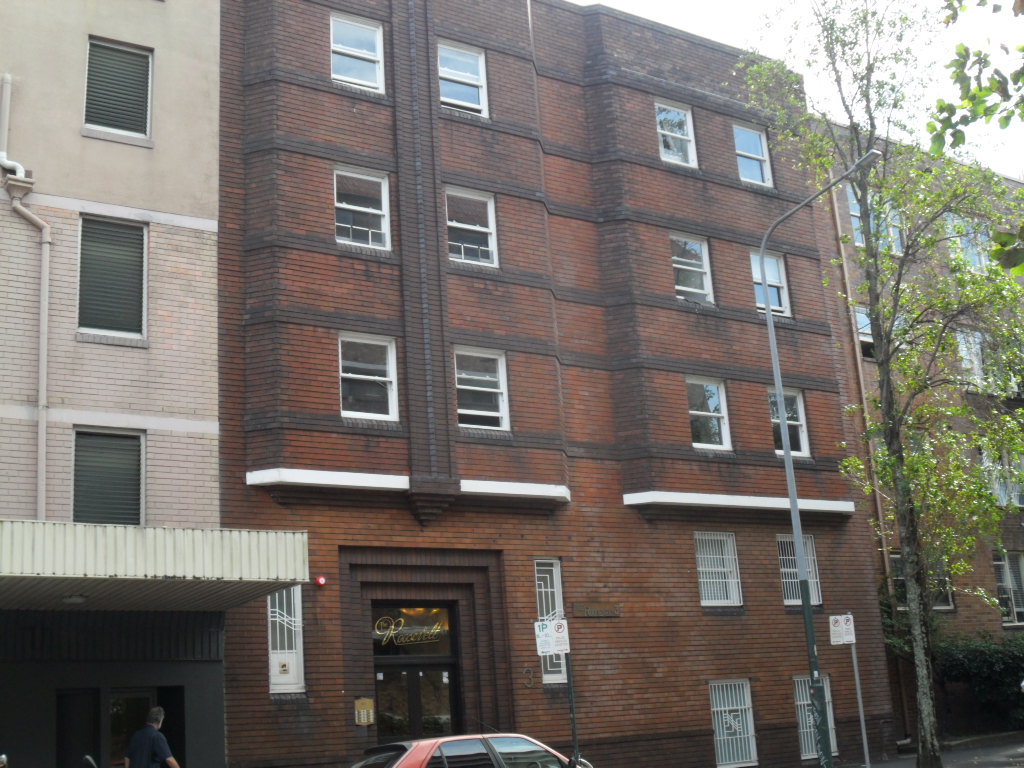Roosevelt Apartments

This three-storey Art Deco apartment block known as “The Roosevelt” at 3 Ward Avene Potts Point was built in 1938 and designed by GN Kenworthy (1885-1954), also known as “Kennie”.
Its 32 apartments features brickwork in three colours, an interesting inset brick architrave entrance surround, florid gold leaf nomenclature lettering, an alabaster dish foyer chandelier, chevron panelling, terrazzo flooring with inlaid patterning and cast iron balustrades.
Kenworthy was a leading Sydney architect and Fellow of the Royal Australian Institute of Architects best associated for his work in partnership with Henry Eli White and for his building designs (particularly theatres) in the Art Deco, Streamline Moderne, Functionalist and Mediterranean styles. He was born in Manchester, England and was first educated at Trinity Grammar School and the Victoria School of Arts in Lancashire. He studied architecture at the University of Liverpool School of Architecture and qualified as an architect in 1906. First articled to Francis Redfern, Kenworthy worked for several leading architectural firms in England before starting his own practice in 1909 in Southport.In 1911 Kenworthy moved to Sydney, Australia, taking up a position in the New South Wales Government Architect‘s Office, where he remained until 1923, having risen to be Architect-in-Chief, Secretary’s Department, Theatres and Public Halls Section. From 1914 to 1922 he was also a part-time lecturer in Architecture at the Sydney Technical College. Until 1951 an examiner for the Board of Architects and the Sydney Technical College, Kenworthy was made a Fellow of the Royal Australian Institute of Architects, having also served on the Institute Council and Education Committee.
In 1923, Kenworthy left the NSW Public Service and became a partner in the firm of Henry Eli White, where he worked on many significant projects in New South Wales, Victoria, Queensland and New Zealand, including fourteen theatres such as the State Theatre, Sydney, Newcastle Civic Theatre, St. James Theatre, Auckland, Hengrove Hall, Macquarie Street, Chalfont Chambers, Phillip Street, St Kilda’s Palais Theatre and the Melbourne Athenaeum. He left White’s firm in 1929 to start his own practice at 105 Pitt Street, Sydney, where he stayed until his death, working all manner of works though theatres were most prominent as “a recognised authority on the design and construction of theatres and auditoria generally”, including the Cremorne Orpheum, Mudgee Regent, Hurstville Savoy, Bankstown Regent and the Port Macquarie Ritz. At a speech to the Institute of Architects at Science House in 1933, Kenworthy observed that the modern theatre building “should be designed for both stage plays and talking pictures, and entrances and foyers should be spacious, and not cluttered up with soda fountains and confectionery counters.”
On his death at his Lindfield residence, aged 69, he was described as “a man of brilliant brain and kind heart … He deeply loved Australia and never returned to England, not even for a holiday, and, to use his own words, has left his mark on the skyline of Sydney.”
By Andrew Woodhouse Heritage solutions





